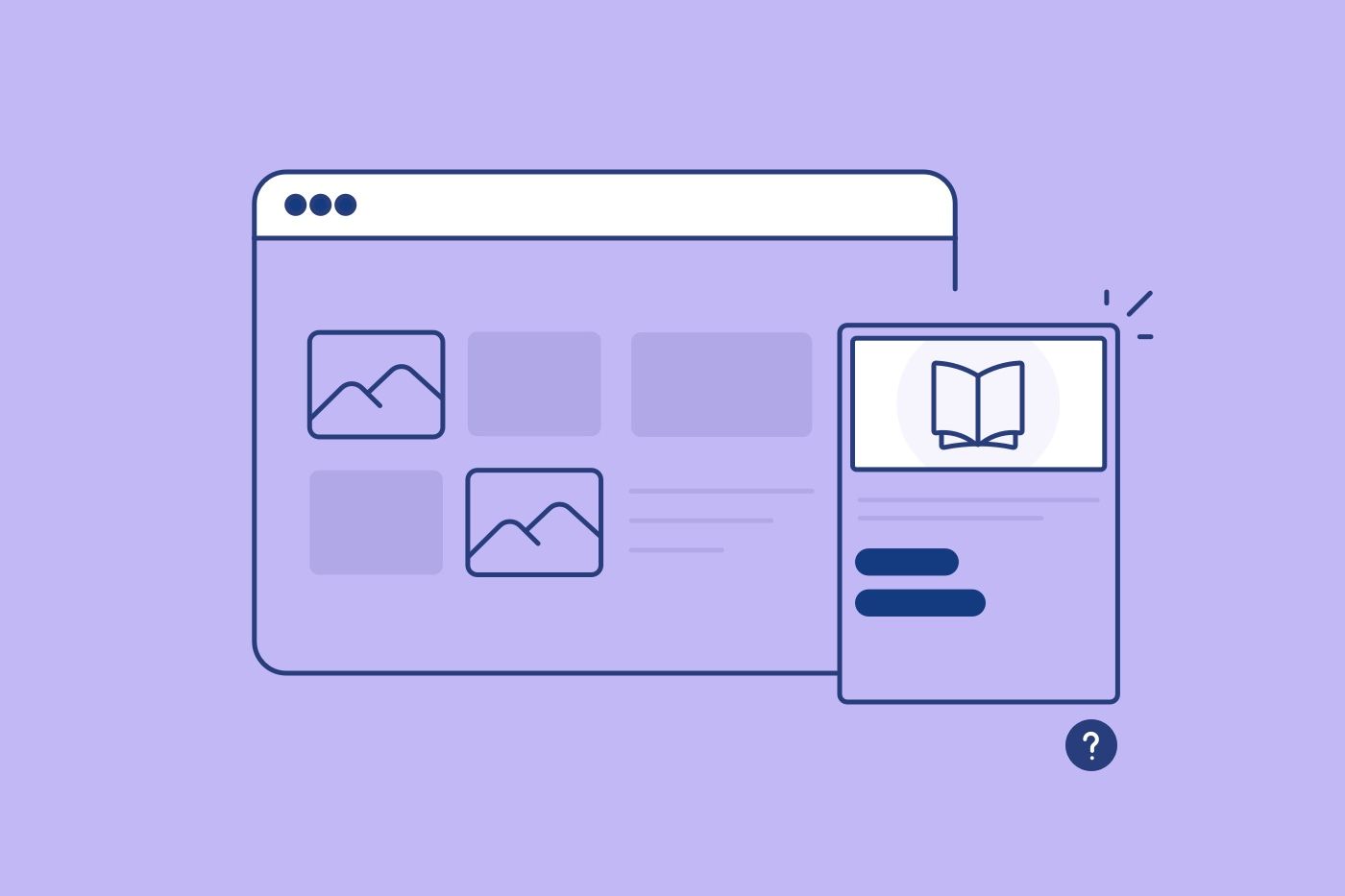If you do self-serve support right, you’ll improve customer success and decrease overall support costs - at the same time. If you do it wrong (or worse, if you don’t do it at all), your competition will leave you in the dust.
Since our product revolves around interactive self-serve support, we’ve talked with hundreds of support professionals across dozens of industries. We learned that everyone’s self-serve strategy is a little different, but the most successful teams follow the same general five-step plan.
Related post: What is a self-service portal?
5 steps for stellar self-serve support
The secret to success with this plan is to focus on steps 1-3 first. Do them now, and get them right. Then move on to steps 4-5.
- Identify your most important self-serve topics
- Create content that will double or triple your ticket deflection ratio on those topics
- Get that powerful content in your customers’ hands before they even consider contacting support
- Build out the rest of your knowledge base efficiently so customers can always get the help they need
- Keep your content up to date, even when your product is constantly evolving
In this article, we’ll walk you through each of these five steps and show you how to make self-serve support a game-changer for your company.
1. Identify your highest-impact, self-servable topics
The Pareto principle suggests that 80% of tickets likely come from 20% of issues. So it pays to focus on creating high-quality self-serve content for those 20% of issues first.
Chances are, you could think of a few obvious self-serve contenders off the top of your head. They’re the questions your customers repeatedly ask you, forcing agents to provide the same canned answers over and over. The topics that you know your customers could resolve on their own, if they just had the right information.
Don’t overthink this part. You know what those topics are. Pick a few, add them to your list, and start with those. Then, use the following tips to identify your other highest-impact, self-servable topics.
How to identify your topics
1. Anticipate your customers’ questions. Based on what you know about your customers and your product, which features/functionalities will they likely need the most help with? On what topics can you be most proactive?
2. Analyze your tickets. What are your most frequently asked questions? Do any of your products or features consistently get more questions than others? Look for those patterns in your ticket data, and use them to decide what topics would serve the most customers if they were in self-serve format.
3. Narrow down. Make a list of your top 10 topic ideas, and ask yourself the following questions about each of them. Whichever topics have the most “yes” answers are the ones you should focus on first.
- Is it high-impact? Does this topic address a core area of your product(s) or service(s)? Is it a barrier to success for customers? For example, at Shopify, setting up a professional looking ecommerce store is a core part of their service. So anything related to website themes is going to be a high-impact topic.
- Is this a high-volume question? How many tickets do you get for this topic on a daily/weekly basis? If the volume is high (and “high” is relative to each support team), creating self-serve content to address it would save your customers and agents a lot of time and effort.
- Is it self-servable? Does the question/topic have a knowable, consistent answer? Could your customers solve it on their own given the right information? Or does it require a unique answer? For example, if a DoorDash customer wants to know how to update their credit card information in the app, that’s self-servable. But if they placed an order and it never arrived, that may require an agent.
2. Create engaging, comprehensive, self-serve content for your top topics
Since these are your highest-impact topics (certain to have the most readers), the content should be comprehensive and detailed. Note: that doesn’t mean it has to be boring.
Many companies make the mistake of trying to cram every possible answer to a question into one long self-serve article. Customers scroll and scroll trying to find information on their particular issue. More often than not, they give up and contact agent support.
Don’t be like those companies. Instead, create self-serve content your customers will actually read by doing these three things:
1. Build out paths for all different use cases
The purpose of self-serve support is to give your users all the information they need to solve a problem without talking to an agent. So your content needs to be as resourceful and adaptable as an agent would be. Think of it as simulating a conversation.
So as you build your self-serve content (we’ll call them guides), consider the potential pathways your customer could need to take to solve their problem. Then use those pathways as a framework, and offer your customers choices throughout the guide. If you make your guide interactive, the content will adapt to your customers’ choices and fast-track them to the right answer.
The screenshot below is from one of our guides, showing customers how to add content to their Stonly knowledge base. Here, you can see a flowchart view of every potential pathway and choice. We can use this step-by-step format to tackle the main pathways with great detail (and add new branches as needed) without overwhelming customers.
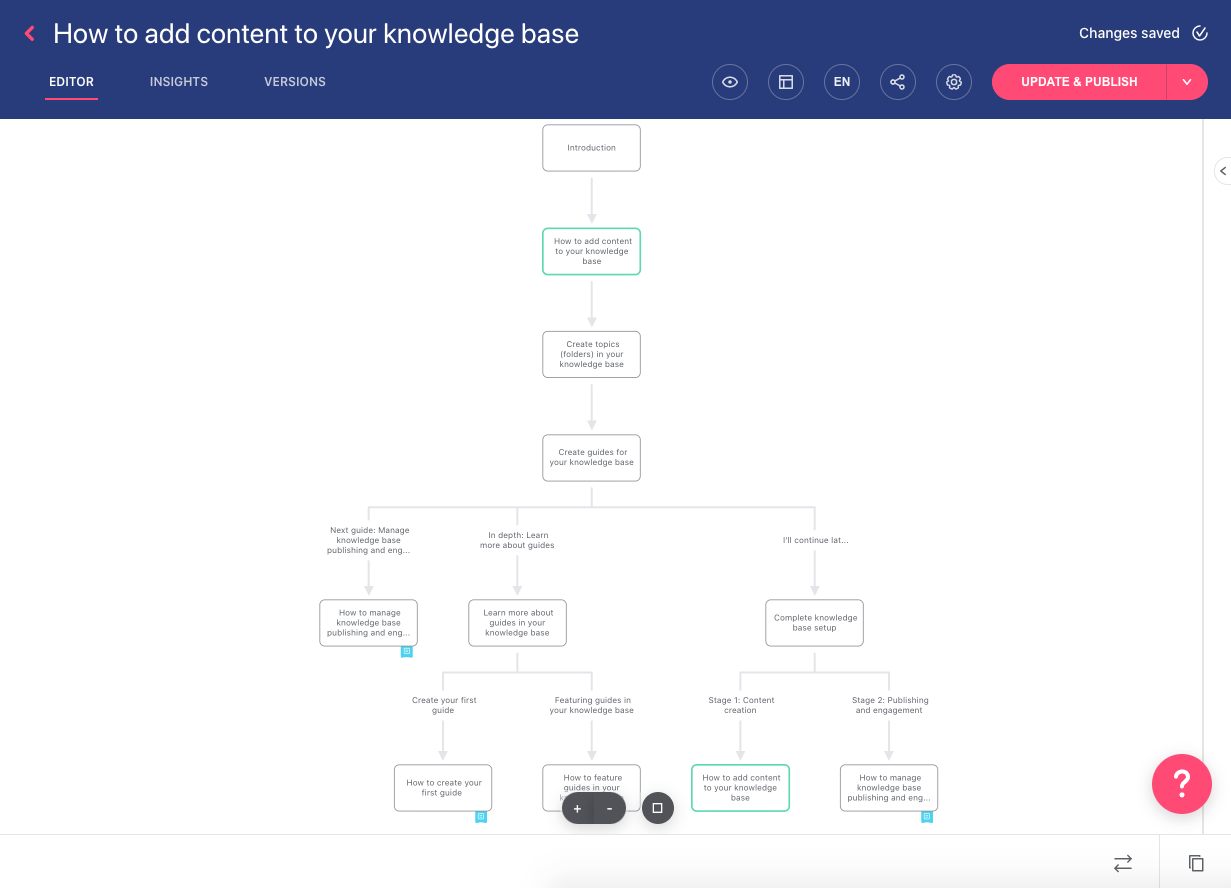
Dashlane made a similar step-by-step guide to answer one of their most common questions: “I forgot my Master Password. What do I do?”
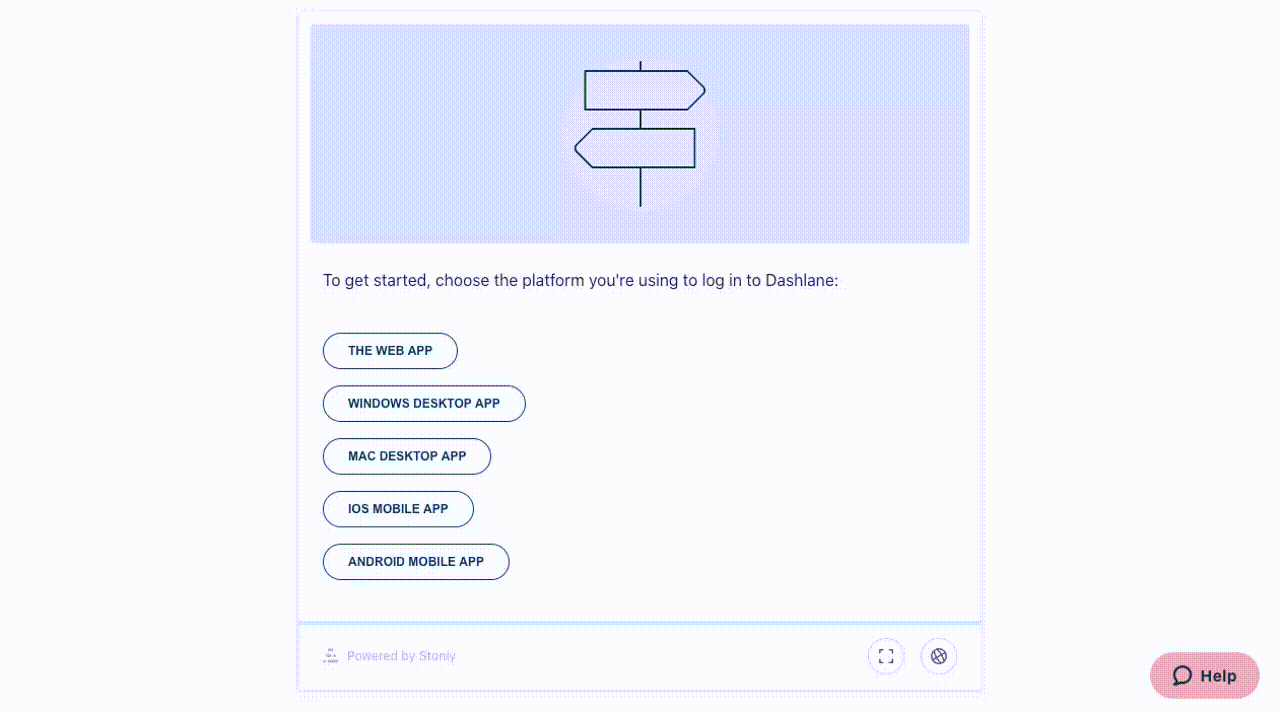
You can see how Dashlane uses choices and interactive pathways to route customers to the right answer based on the platform they use to log in (desktop app, mobile app, IOS, Android, etc). Rather than force agents to troubleshoot this same issue over and over, Dashlane made a guide with all of those potential pathways in one place. And now their customers don’t have to sift through information that’s not relevant to them.
Related Post: 10 Best FAQ Software Tools for Customer Support
2. Invest time in media
Like any content, your self-serve support content should rely heavily on visuals. Media is what helps your readers literally see their situation. Don’t just tell them what to do. Show them.
If you use photos or screenshots, you can place them side-by-side with your text in any given step to help reinforce the concept you’re teaching. Use arrows, shapes, and lines to draw attention to specific things in the photo. For example, if in a step you tell your customer to click a button, make sure to highlight that button in your visual. Remember, what you think is obvious may not be so obvious to customers. So when it comes to visuals, it’s always better to err on the side of over-communicating.
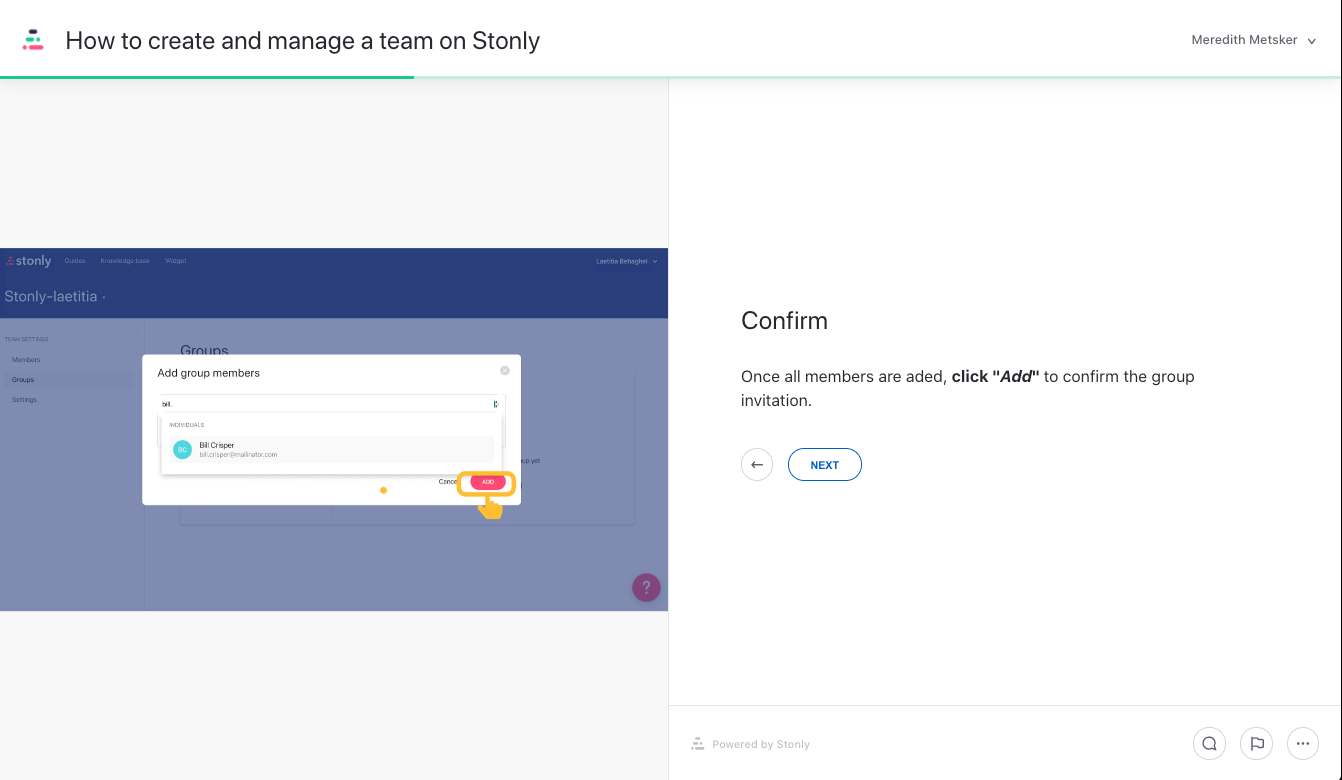
Videos are a great way to add more context or explain more complex concepts. With Stonly, you can even break up one video and place each section with its corresponding guide step. That way, if you change one small feature in your product, you may only need to re-record one or two sections of the video instead of the entire thing.
Pro tip: Screen capture tools like Loom are great for making videos for step-by-step guides.
If you need to show movement (or maybe 1-3 actions on a loop), but don’t need a full video, GIFs are a great option. You can use a tool like Crello to convert a video file into a high-quality GIF.
3. Make related content easily accessible
Your knowledge base articles aren’t independent. Rather, they’re an interconnected web of help guides. So as you build your self-serve support content, always think about what your customer might want to read next. What other questions might they have around that topic? What can you offer them that will make them even more successful?
Whether it’s hyperlinks or a “Related Content” section, make sure that any relevant, related content is easy for the customer to find - while they're still in the mood to learn.
3. Deliver self-serve support at the right time and place
Now that you've identified your most important topics and created engaging, detailed content to cover them, you need to make sure people find that content when they need it.
This is one of the biggest issues we see. Companies say "We have the content, but customers still contact support.” Sometimes that's because the content isn’t helpful enough. Often, it's simply because people don't find it. If it's easier to contact support, that's what they’ll do.
When thinking about how to get your self-serve content in front of the right people, you want to be both proactive and reactive.
Proactive delivery
Proactively, content is delivered before a customer even notices that they have a problem. To do this well, you need to know where people are when they have a certain issue.
For example, if a lot of people have trouble with one of your topics on a certain page or section of your site, you can offer a step-by-step guide the first time they land on that page. Surface it in a widget so it's easy to find but not intrusive. Even if the customer doesn't read the guide immediately, they know it's available and where to find it.
In our guide editor, we make our entire knowledge base accessible via in-app widget. That way, if a customer is building a Stonly guide and has a question, they can find an answer without losing their momentum.
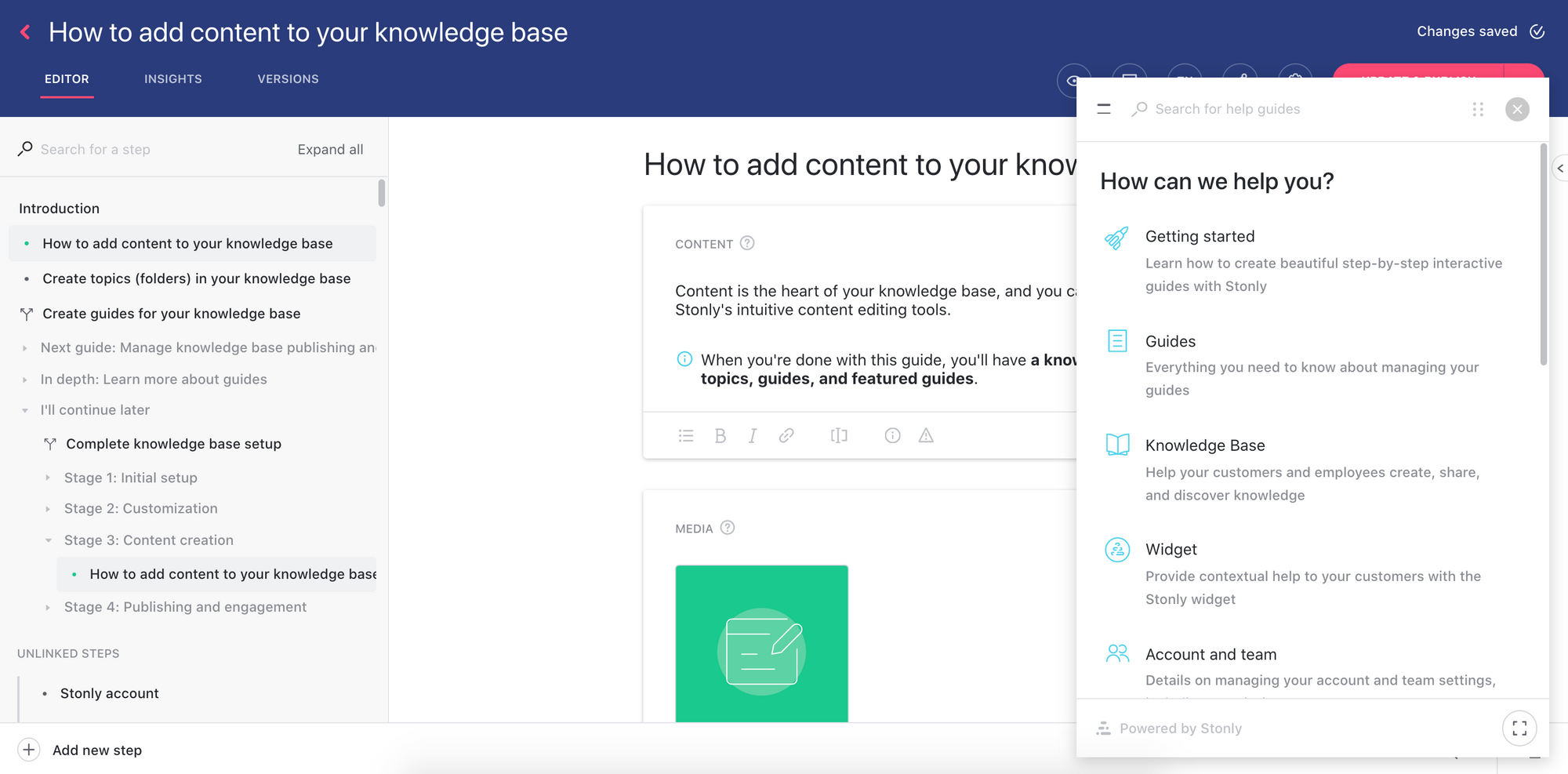
Wherever customers use the functionalities mentioned in your most important topics, you should add tooltips. But not just any tooltips. Add tooltips that open up your powerful, robust help content so users can learn how to avoid common issues.
Here at Stonly, we’ve added tooltips to our tooltip builder (very meta) because we know our customers often have questions about how to place them on their websites. Instead of forcing our customers to contact support, we built a guide on the topic and added a tooltip that opens the guide. Now we receive almost no tickets on that topic even though more people are using the feature than ever before.
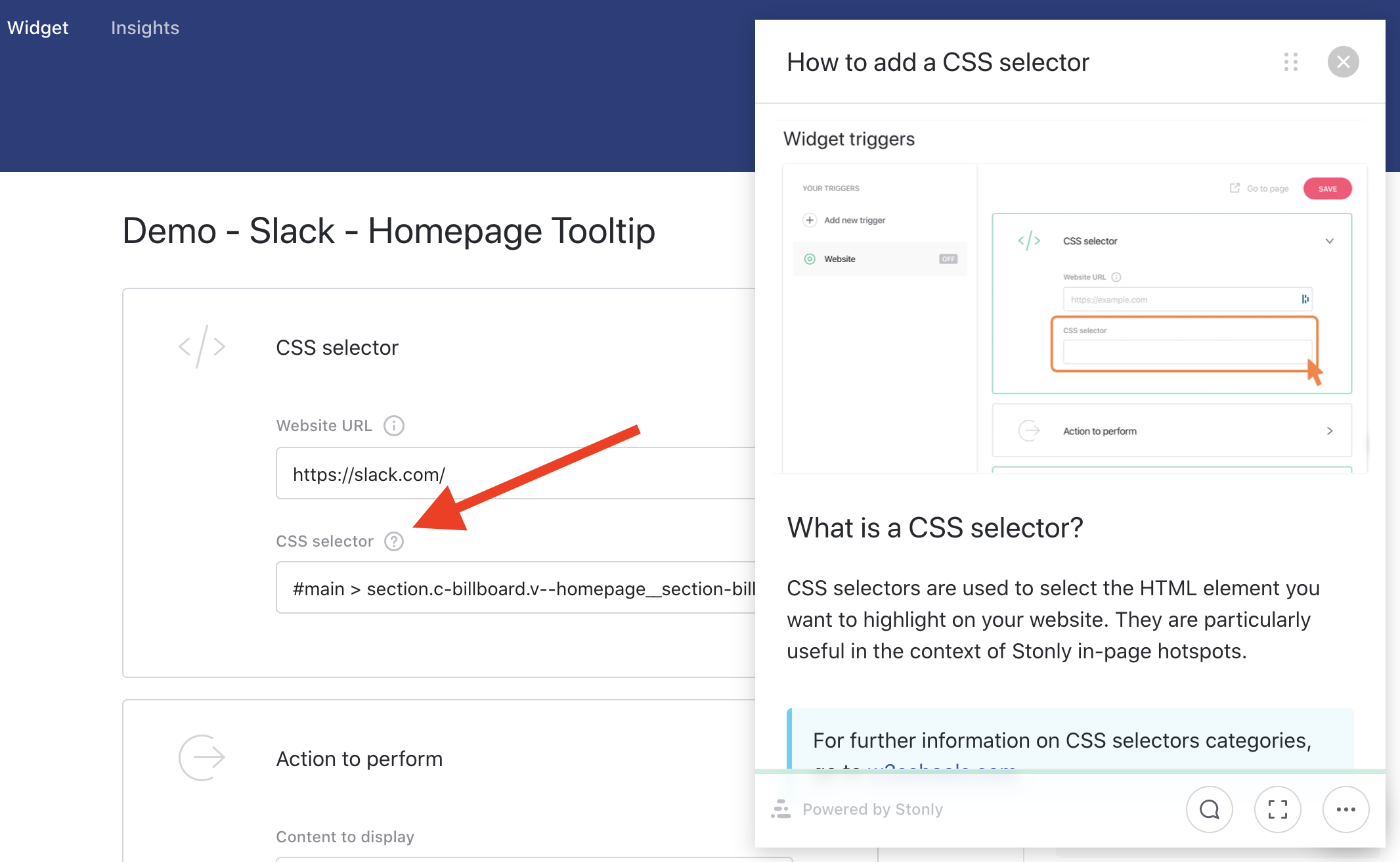
Reactive delivery
Reactively, you can offer content as a first line of defense when a customer tries to contact support. Don't think of it as blocking people from talking to your team or deflecting tickets. Instead, you’re trying to offer the right solution as fast as possible. Content offers immediate help, while agent support requires an extra step and a delay.
One way to do this is a smart contact form, like Stonly’s. When a user says they want to contact support, we use the form to ask why and nudge them toward content that answers their question. If they still want to talk to an agent, they can. But we’ve at least given them the opportunity to self-serve on the spot.

You should also make sure your self-serve guides are easy to find in your knowledge base. Add them to your “Featured Guides” section, put them first in their respective categories, and make sure they appear when users search for relevant terms - both in your knowledge base and on Google.
By making your most powerful guides on your most important topics easier for customers to access, you’ll see an increase in success, a decrease in tickets, and improved morale on your support team - a rare and elusive win-win-win.
4. Build out the rest of your knowledge base
Once you create top-notch help content for your high-impact topics, you’ll want to build out the rest of your knowledge base. Here’s how to get started:
1. Cover all topics
Not every help article is going to be as detailed as your high-impact help content, and that’s okay. The important thing is to cover all topics. Prioritize getting something published on every topic, even if it’s not perfect or in-depth. You can always go back and add more detail later.
As you’re deciding what topics to include in your knowledge case, start with an article for every product, major functionality, and integration. Drill down from there, looking at more specific topics within each of those categories.
To borrow a SaaS concept, think of your early knowledge base in terms of MVP (minimum viable product). What’s the minimum amount of content you need to make your knowledge base viable?
For example, Tacklebox launched their knowledge base at the same time they launched their product. So they built their entire knowledge base specifically to cover the most important topics they knew their new customers would need to learn more about. They put 90% of their effort into those most important topics and deprioritized the rest until after launch.
2. Make it searchable and well categorized
Your knowledge base categories should be based on customers and how they think about your product. Tacklebox splits their knowledge base into three categories, based on user intent:
- A simple, easy-to-understand getting started section
- A robust documentation section that covers all the main aspects of using their product
- A simple account and billing section
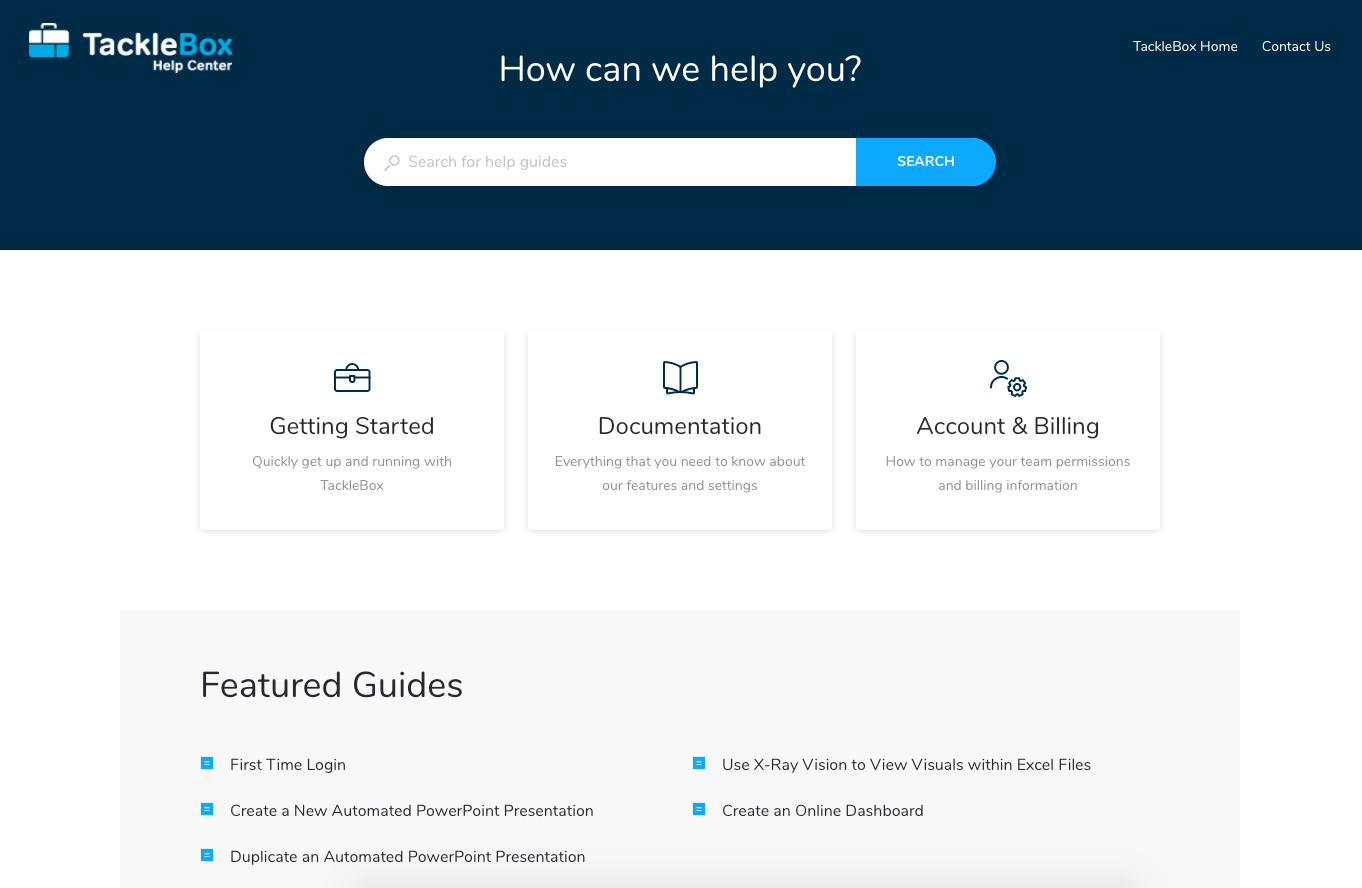
That’s a pretty standard knowledge base setup for SaaS companies. For ecommerce, the main categories might include:
- Shipping and delivery
- Returns and refunds
- Managing your orders
- Product information
Regardless of industry, you should also include a “Featured Guides” section for your high-impact guides, like Tacklebox does.
Make it easy for customers to self-identify their issues by using their language, not your internal jargon. Pay attention to how customers talk about their issues in sales and support calls. Make note of the words they use to describe your products/features in interviews and satisfaction surveys. Include those words in the titles and text of your articles, so they’ll appear in search results when a user is on the hunt for an answer.
If you’re consistently mindful about how you choose, structure, and write your self-serve support content, your knowledge base will be inherently searchable.
3. Make your knowledge base easy to find
Customers shouldn’t have to look hard to find your knowledge base. Link to it in relevant blog posts, newsletters, feature announcements, etc. Put it in a prominent position in your main navigation or in your footer. Here’s how we do it in our footer:
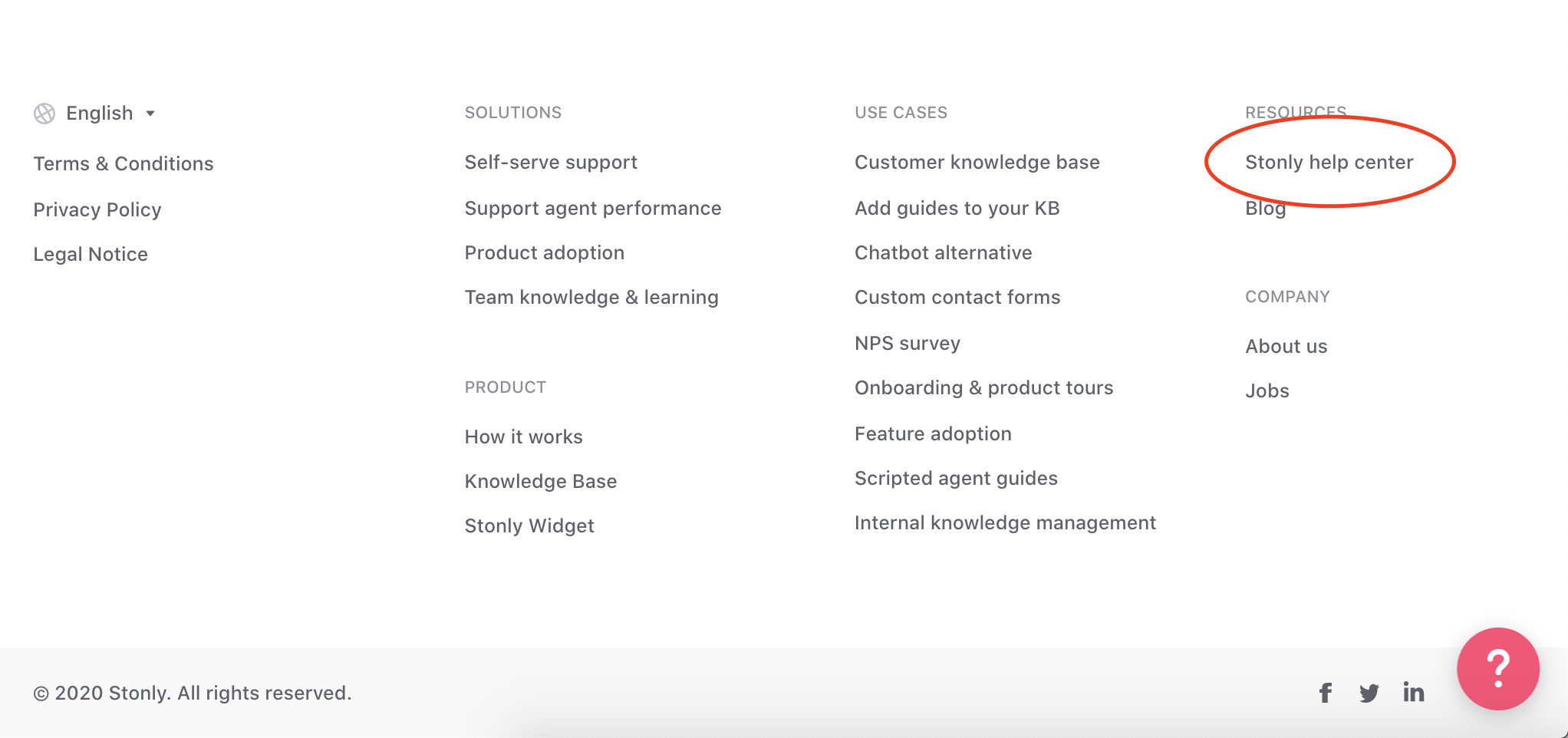
Better yet, offer your entire knowledge base directly in your app so people can get help, in real time, without leaving their tab. Here’s how we do that on our site via Stonly’s in-app widget.
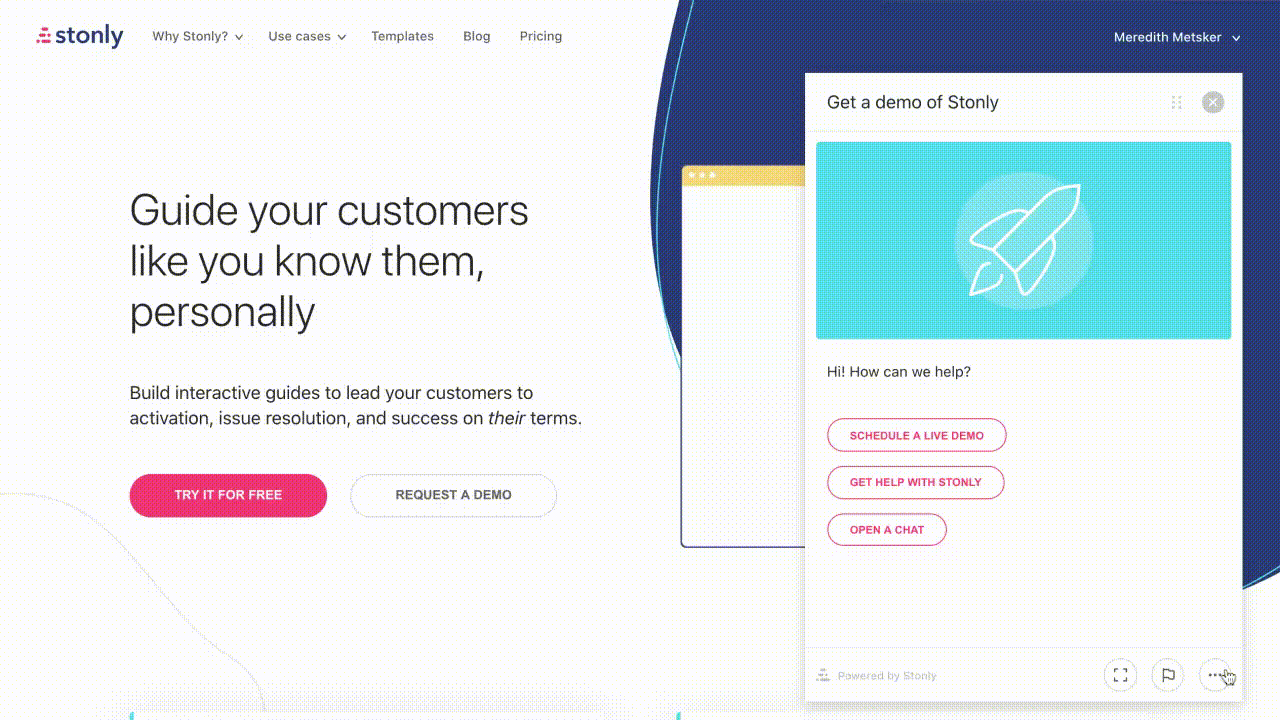
5. Keep your self-serve content up-to-date
You know as well as we do that maintaining self-serve content is just as important as creating it. That includes keeping all text and visuals up-to-date, so your customers always have access to accurate resources.
As your knowledge base grows, use these tips to streamline the maintenance process:
1. Keep up with product. Make someone on the product team accountable for knowledge base updates, alongside the support team. Add and update self-serve content as you release new features. Require documentation to be complete before a product is launched (like Tacklebox did).
2. Make a process for revisiting each article. Decide how often you’ll review your help content, and use a spreadsheet (or whatever format works for you) to keep track. Think of it like an elevator inspection sheet.
3. Make it easy to submit support article bugs. Employees and customers are often the first to spot an error or outdated information. Make it simple for them to let you know when there’s an issue, so you can fix it right away.
4. Conduct a regular audit. As your company grows, make sure you don’t have duplicate content. Instead, hyperlink to the relevant article so when there’s a change, you only have to update one piece of content. Try our knowledge base audit template.
Bonus: Make a smooth handoff to agent support
Nothing frustrates customers like spending time trying to find self-serve help only to have to contact support and explain everything they just tried. It’s a terrible experience.
But with a smooth, data-driven handoff, it’s like magic. When the agent has access to the customer’s usage history, they can see what the customer has already tried and pick up right where self-serve left off. It’s the perfect way to delight customers when they’re in the middle of a poor experience.
For example, in the screenshot below, we can see how much time the customer spent on each step in a self-serve guide and where they got stuck. Knowing that, your agent can tailor their response and cut out the back-and-forth.
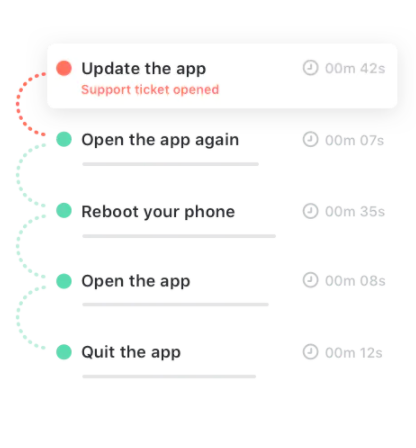
Start creating your self-serve content today
Sign up for a free trial of Stonly or schedule a call to start delivering instant, personalized, self-serve support - wherever and whenever it’s needed. No code required.
Related post: What is a self-service portal?

